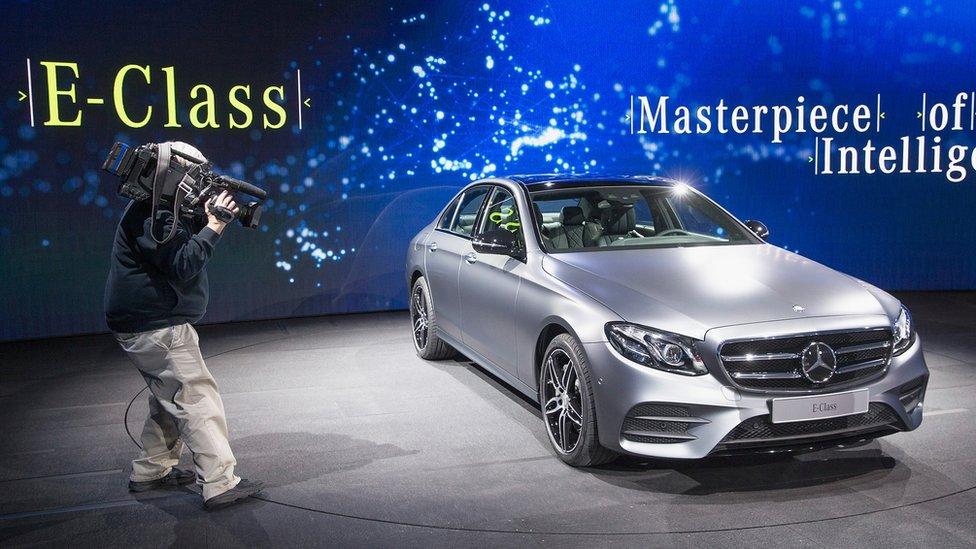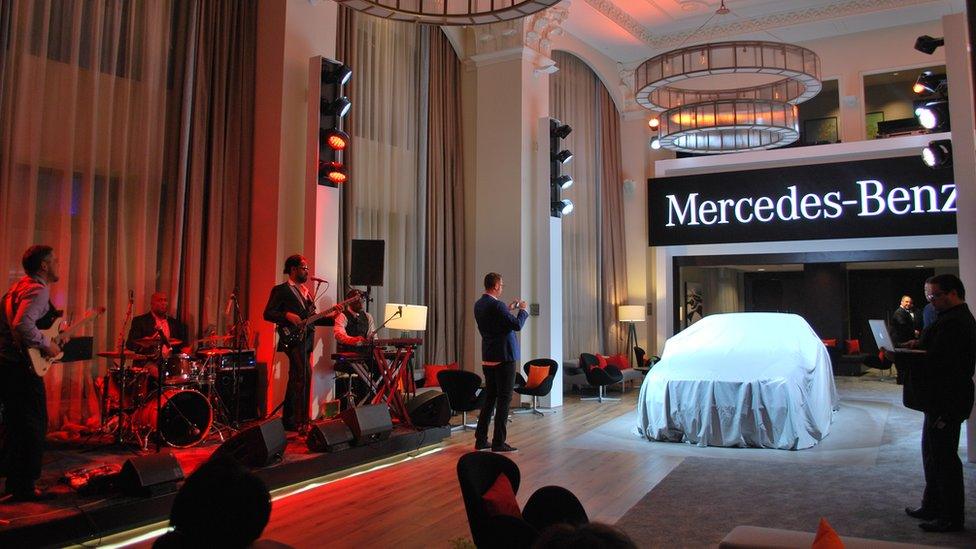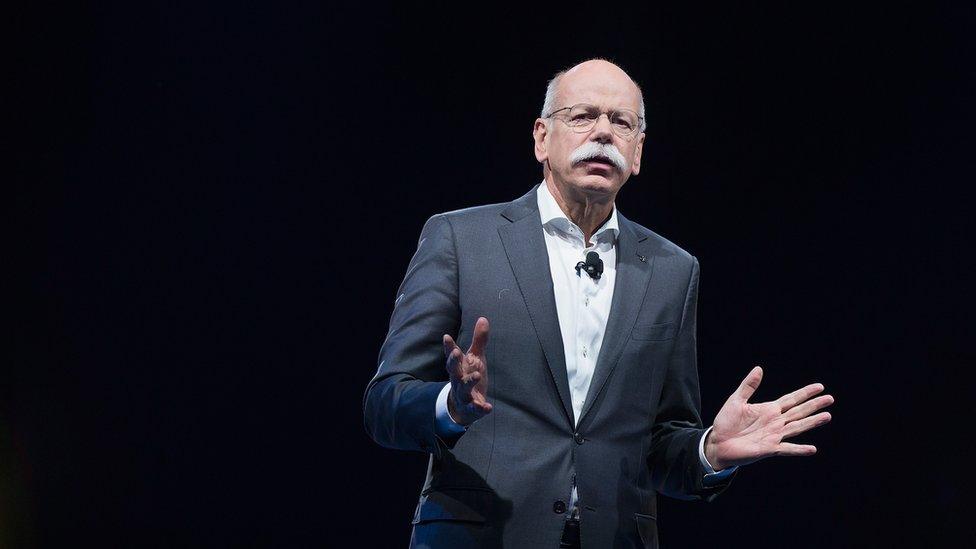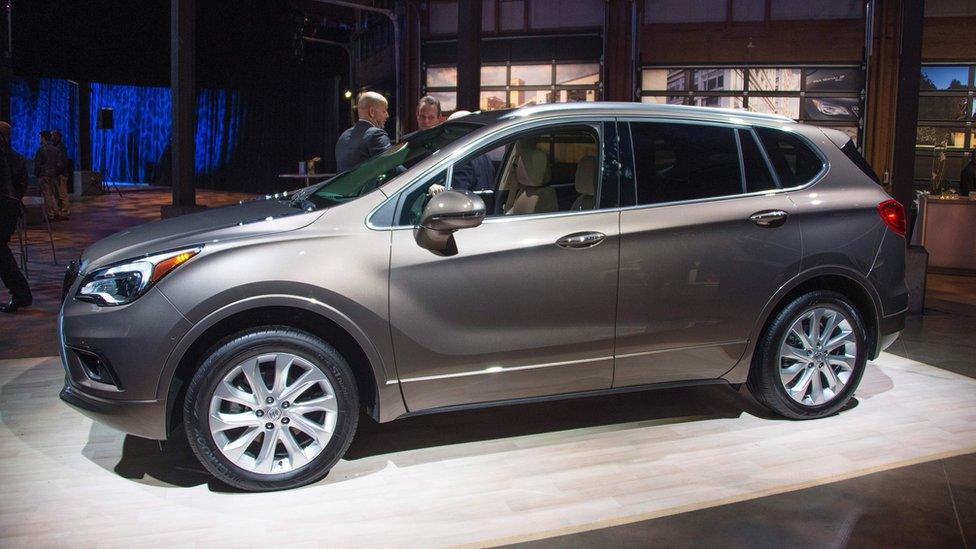Carmakers showcase road ready innovation
- Published

Mercedes is giving its E-Class a major push at the motor show
The sound of revving engines, the excitement of new car launches, and a healthy dusting of snow, all mean it is time for the 2016 Detroit Motor Show to cross the start line.
There is no question that the US car industry is back and booming. 2015 was a record year for car sales in the US, and 2016 is expected to be just as strong.
Carmakers are not taking any chances though, displaying the latest luxury, the coolest tech features, and of course, the fastest motors at the North American International Auto Show in Detroit.
But unlike the futuristic vehicles on display at the Consumer Electronics Show in Las Vegas last week, carmakers in Detroit are keen to emphasise cars can be driven now.
Take the 2017 Mercedes-Benz E-Class, unveiled at a chic event on Sunday night.
The car is the closest thing to a driverless vehicle that can legally be taken on the road. It features remote control parking via a smartphone app, evasive manoeuvre assistance to help avoid road hazards, and cruise control that changes speed based on road signs.
The E-Class practically begs drivers to do something risky, just so it can take control. In case there is an accident, the car's sound system emits a noise to prevent hearing loss, and pushes the front-seat occupants towards the centre if the vehicle.
And still the car's most impressive feature is - it is road ready. Mercedes plans to start selling the 2017 E-Classes in the US this summer.

Mercedes offered food and live music to mark the grand unveiling
Dieter Zetsche, head of Mercedes-Benz, says innovation like autonomous driving has been motivated in part by players outside the industry, like Google. But he says for the car to sell it must "consist of more than just autonomous driving".
"It is good to have competition from outside the industry because it makes us strive to even better performance, but at the end of the day we will see who succeeds in front of the customer," says Mr Zetsche.
Cheap fuel
Autonomous driving, smart cars connected to smart homes, and gesture controlled cars, all seem amazing, but are years away from being ready.
Carmakers know drivers are ready to buy new cars, and they want to be the beneficiaries of that spending. So most cars at motor shows do not just have to be cool - they have to be real.

Dieter Zetsche says that drivers will always want more than a car which can drive itself
Approximately 17.5 million cars were sold in the US in 2015 - making it the best year on record for the industry. According to the National Automobile Dealers Association, 17.7 million cars are likely to be sold in 2016.
Part of the reason is the economic recovery in the US. Credit continues to be cheap, and the anticipation that it will get more expensive as the Federal Reserve raises interest rates has encouraged people to take out car loans sooner than later.
Another reason is the age of the cars most people are driving. The average car on the road in the US was 11.5 years in July 2015, according to IHS Automotive.
Americans held on to their cars longer as they waited for the economy to improve. During that time drivers were able to dream about the vehicles and features they wanted.
Falling oil prices have helped too.
'Drive now'
The Detroit Motor Show is a chance for carmakers to show that while buyers were waiting, they were making improvements and creating new designs that are ready to fulfil those fantasies.
"Most of the debuts in Detroit are cars people can drive now or very soon," says Michelle Krebs a senior analyst at autotrader.com.

The new Buick Envision is made in China
Ms Krebs adds that car companies can no longer afford to produce "ridiculous concept vehicles that bear no resemblance to reality".
Car companies need vehicles that can generate a profit in the near term, which is why the vehicles released at car shows have become more and more like their road ready offspring.
Though just because the cars have to reflect some amount of practicality doesn't mean the companies are ditching the fanfare. Mercedes held a glitzy launch event at one of Detroit's top hotels, where the E-Class could be admired with a cocktail and tiny hors d'oeuvres served on large spoons.
Ten minutes away General Motors rented out Detroit's hip Easter Market to host a warehouse party for its Buick line.
The event featured the Buick Envision, another example of practicality in action. The company says the small sport utility vehicle (SUV) fills a gap in Buick's line up, and includes such snazzy features as a turbo-charged four-cylinder engine and parking assistance.
The most significant part of the Envision though is that it is built in China.
The Envision will be new to the US market, but has been sold in China for more than a year.
The company says building in China allows them to use existing plants and begin selling the car in the US by the summer. Buick is banking on Americans' desire to buy cars now, over any hesitations about where the car is made.
The motor show opens to the public on 16 January, and there will certainly be exciting new models and tech to see.
Rather than enticing drivers to dream about the cars of the future though, expect carmakers to show off the coolest vehicles ready to hit the open road.